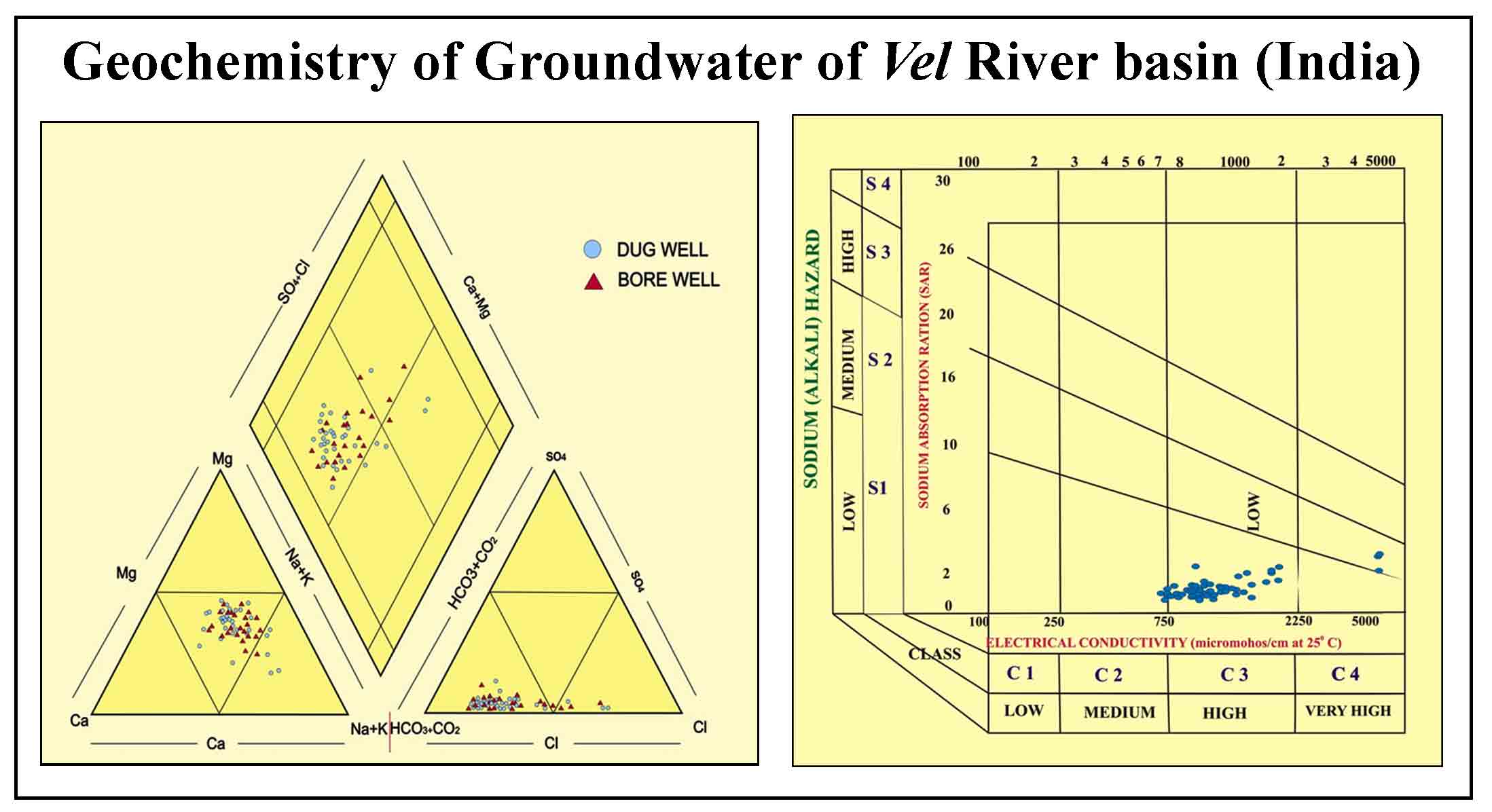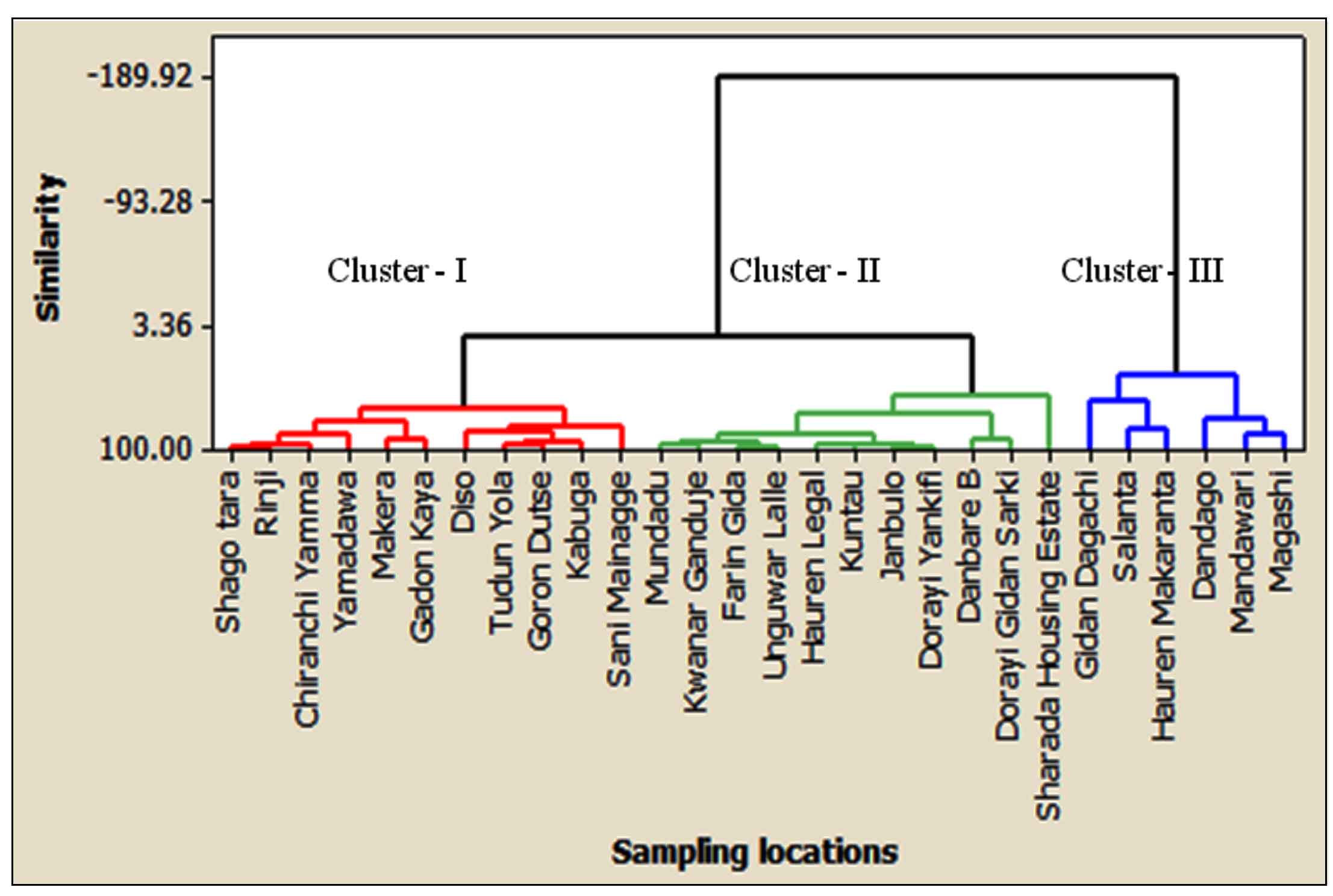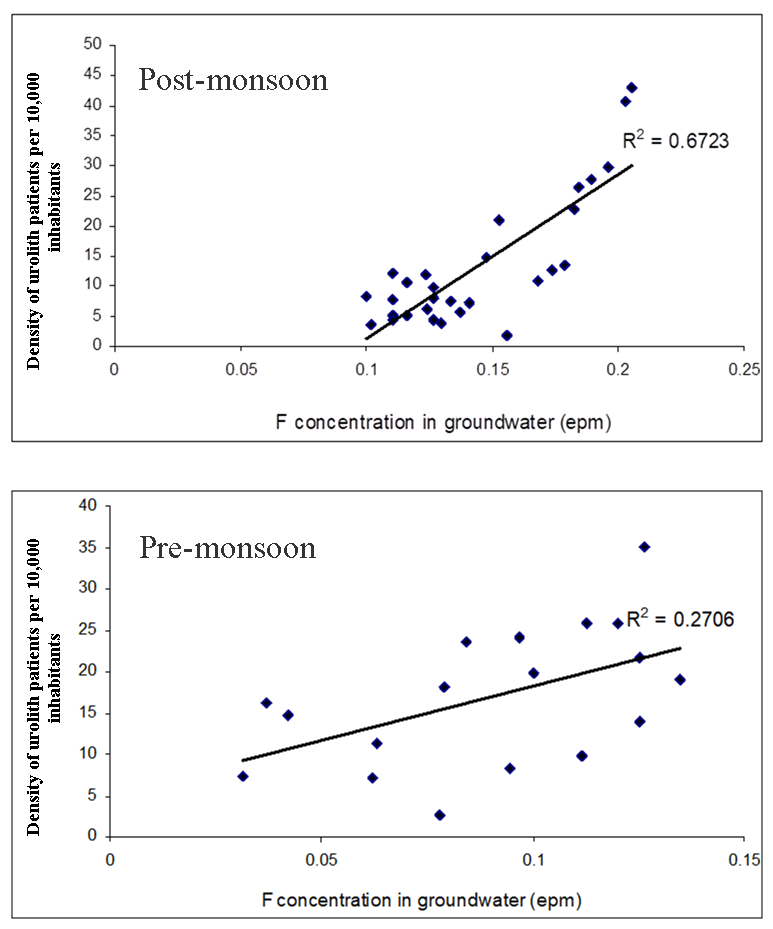Article Title :
Assessment of Groundwater Geochemistry of Vel River basin, Western Maharashtra, India
Satyajit Gaikwad, Nasir Pathan, Nikhil Bansode, Suryakant Gaikwad, Yogesh Badhe, Tejas Naik, sneha sawant
4 (2020)
14-28
Chemical Concentrations , Geochemistry , Groundwater , Physicochemical Parameters , Vel River basin


To study the chemistry of major ion in groundwater from Vel (Velu) River basin, sixty (60) samples of dug wells and bore wells were collected and analyzed using standard techniques given by APHA. It shows order of dominance for cations, Na+ > Ca2+ > Mg2+ > K+ and in anionic concentration as HCO3- > Cl- > SO42- in groundwater. The pH of groundwater is slightly alkaline (range: pH 7.0 - 8.1), while average values of Electrical Conductivity (EC) is about 2641 µS/cm indicating high mineralization of groundwater. In general, the cationic concentration (Na+, K+, Ca2+ and Mg2+) of the groundwater increase in the downstream side (from Northwest to South east), suggesting geological control on the composition of groundwater while highest concentration is in lower part of the basin are generally associated with the high salinity. In the major anions, bicarbonate (HCO3-) is higher due to rock-water interaction. Average value of chloride is about of 235 mg/L due to discharge zones along with anthropogenic activities. The geochemical data plotted on Piper Trilinear Diagram is showing dominant hydro-chemical facies: Ca2++Mg2+, Na++ K+, Cl-+ SO42- -HCO3- found in 83.3 % samples indicating the alkaline earth exceeding the alkalis and the strong acids exceeds the weak acids. The pH, Total Hardness (TH) and Magnesium (Mg2+) of the samples show more proportion of samples falling above desirable limit. Otherwise the quality of groundwater is good for drinking. The irrigation indices like SAR, KR and SSP were considered to evaluate groundwater suitability for irrigation. Comparing with SAR parameter all samples are excellent to good for irrigation. In SSP, 33.3 % samples are within permissible, while 66.6% samples are doubtful for irrigation purpose. In KR almost all samples (excluding 04 samples in lower side of basin) are suitable for irrigation. So, variations in climate, geology with anthropogenic activities are modifying the groundwater geochemistry of Vel River Basin.

Area under study is covered with Deccan Basalt and aquifers are mostly fractured and compact in upper and middle part of the basin.
Most predominant cations are Na and Ca followed by Mg while in anions HCO3, and Cl are dominant anions than SO4.
The dominant hydrochemical facies Ca+Mg, Na+K; Cl+SO4 HCO3 facies, found in 83.3 % samples indicating the alkaline earth is exceeding the alkalis and the strong acids exceeds the weak acids.
The data compared with World Health Organization standards found that pH, Total Hardness (TH) and Magnesium (Mg) of the samples are more % of samples falling above Desirable limit.
Different parameters like Sodium Absorption Ratio (SAR), Soluble Sodium Percentage (SSP) and Kelly ratio (KR) have been calculated to analyse the quality of water for irrigation.
In SSP, 33.3 % samples are permissible, while 66.6% samples are doubtful for irrigation purpose.
Alamary, A. S., 2005. An integrated approach for groundwater exploration in the lower part of Wadi Meifaah, Republic of Yemen. Unpublished PhD. Thesis, Univ. of Pune, India, 1-136.
APHA [American Physical Health Association], 2005. Standard methods for the examination of water and wastewater, 21st Ed. American Public Health Association, New York.
Brindha, K., Rajesh, R., Murugan, R., and Elango, L., 2010. Natural and anthropogenic influence on the fluoride and nitrate concentration of groundwater in parts of Nalgonda district, Andhra Pradesh, India. Journal of Applied Geochemistry, 12 (2), 231-241.
CGWB [Central Groundwater Board], 2012. Guide Manual: Water and Wastewater Analysis, 1-189.
CGWB [Central Groundwater Board], 2013. Groundwater information, Pune district, Maharashtra. Technical Report, 1810/DBR/2009.
Domenico, P. A., 1972. Concepts and models in ground-water hydrology. New York: McGraw-Hills.
Drever, J. I., 1982. The Geochemistry of Natural Waters. Prentice Hall, 1-182.
Gaikwad, S. K and Pawar, N. J., 2008. Spatio-temporal geochemical distinctiveness of ground waters allied to lithological diversity in the area between Karli and Terekhol Rivers, Southern part of Coastal Maharashtra, India. International Groundwater Conference on Groundwater dynamics and global change, Organized by University of Rajasthan, Jaipur, March, 2008.
Gaikwad, S. K., Gaikwad, S. P., Date, D. V., Borhade, S. T., Kandekar, A. M., Supekar, A. H., Bhagat, R. S., Kambale, P. N., Madale, R. B., Raut, T. P. and Kadekar, O. S., 2018. Groundwater quality analysis of an emerging part of suburb of Pune Metropolitan Region, Maharashtra, India using GIS and Remote Sensing Techniques. Hydrospatial Analysis, 2 (2), 91-101.
Gaikwad, S. K., Kadam, A. R., Ramgir, R. R., Kashikar, A. S., Wagh, V. M., Kandekar, A. M., Gaikwad, S. P., Madale, R. B., Pawar, N. J. and Kamble, K. D., 2020b. Assessment of the groundwater geochemistry from a part of west coast of India using statistical methods and water quality index. HydroResearch, 3, 48-60.
Godbole, S. M., Rana, R. S. and Natu, S. R., 1996. Lava stratigraphy of Deccan basalts of western Maharashtra. Gondwana Geological Magazine Spl. Publ. 2, 125-134.
GSDA [Groundwater Survey and Development Agency], 2003. Systematic Hydrological Survey reports Groundwater Survey Development Agency (unpublished).
GSI [Geological Survey of India], 2001. District Resource Map of Pune.
Kelley, W. P., 1951. Alkali Soils-Their Formation, Properties and Reclamation. Reinhold Publication, New York.
Matthess, G., and Harvey, J. C., 1982. The properties of groundwater, John Wiley and Sons, New York, 1-397.
Melluso, L., Sethna, S.F., Morra, V., Khateeb, A. and Javeri, P., 1999. Petrology of mafic dyke swarm of the Tapti River in the Nandurbar area, Deccan Volcanic Province, Memoir Geological Society of India, 43(1), 735-738.
Nikumbh, J. D., 1997. Geochemistry of groundwaters from Behedi basin, District-Nasik, Maharashtra. Unpubl. Ph.D. Thesis, University of Pune, India, 1-153.
Pawar, N. J. and Nikumbh, J. D., 2007. Mass Balance Modelling of Groundwater’s from shallow basaltic alluvial aquifers of Behedi Basin, Nasik District, Maharashtra. Gondwana Geological Magazine, 11, 23-34.
Powar, K. B., 1987. Evolution of the Deccan Volcanic Province. Presidential Address, (74th Session), Geol. and Geog. Section, Ind. Sci. Cong., 1-29.
Sethna, S. F., Ateeq, K. and Javeri, P., 1996. Petrology of basic Intrusive in the Deccan Volcanic Province South of Tapti Valley and their comparison with those along the west Coast. Gondwana Geological Magazine, 2, 225-232.
Subbarao, K. V., Chandrashekharam, D., Navaneethakrishanan, P. and Hooper, P. R., 1994. Stratigraphy and Structure of Parts of the Central Deccan Basalt Province: Eruptive Models. Volcanism, 321 - 332.
Subbarao, K. V., Ramasubbareddy, N. and Prasad, C.V.R.K., 1988. Geochemistry and Palaeomagnetism of dykes from Mandaleshwar region, Deccan Basaltic Province. Geological Society of India, Mem.10, 225-233.
Supekar, A. H., 2011. Occurrence and distribution of heavy metals in the groundwater resources of Pune Metropolitan area: A study based on GIS technique. Unpublished Ph. D Thesis, University of Pune, 1-256.
USSL [United States Salinity Laboratory Staff], 1954. Diagnosis and improvement of saline and alkali soils, Handbook 60. US Department of Agriculture, New York.
Wagh, V. M., Mukate, S. V., Muley A. A., Kadam, A, K. Panaskar, D. B. and Varade, A. M., 2020. Study of groundwater contamination and drinking suitability in basaltic terrain of Maharashtra, India through PIG and multivariate statistical techniques. Journal of Water Supply: Research and Technology-Aqua, 69 (4), 398-414.
Wagh, V. M., Panaskar, D. B., Varade, A. M., Mukate, S. V., Gaikwad, S. K., Pawar, R. S. Muley A. A. and Aamalawar, M. L., 2016. Major ion chemistry and quality assessment of the groundwater resources of Nanded tehsil, a part of southeast Deccan Volcanic Province, Maharashtra, India. Environmental Earth Sciences, 75(21), 1418.
Wallick, E. I. and Toth, J., 1976. Methods of regional groundwater flow analysis with suggestions for the use of environmental isotope and hydrochemical data in groundwater hydrology. 37-64, Vienna: IAEA.
WHO [World Health Organization], 1997. International standards for drinking water. Geneva.





